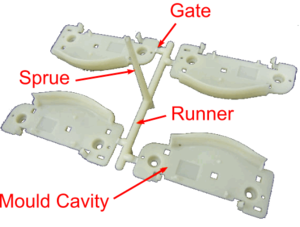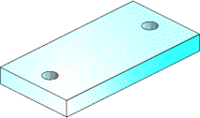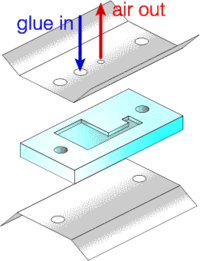Injection Moulding: Difference between revisions
From DT Online
(Created Article) |
mNo edit summary |
||
| (8 intermediate revisions by the same user not shown) | |||
| Line 1: | Line 1: | ||
[https://en.wikipedia.org/wiki/Injection_moulding '''Injection Moulding'''] is the most commonly used manufacturing process for the production of a great variety | [[File:Mold cavity.png|300px|right]] | ||
__TOC__ | |||
=====Description===== | |||
[https://en.wikipedia.org/wiki/Injection_moulding '''Injection Moulding'''] is the most commonly used manufacturing process for the production of a great variety plastics products and components ''(inc. parts for plastics model kits for example)'' | |||
[[File:Principe moulage injection polymere.svg|300px|right]] | [[File:Principe moulage injection polymere.svg|300px|right]] | ||
In industry, plastics granules are drawn into an [https://en.wikipedia.org/wiki/Injection_molding_machine '''Injection Moulder'''] cylinder, or barrel, via a rotating screw to a point where they are heated and melted. The screw then operates as a piston and forces the melted | In industry, plastics granules are drawn into an [https://en.wikipedia.org/wiki/Injection_molding_machine '''Injection Moulder'''] cylinder, or barrel, via a rotating screw to a point where they are heated and melted. The screw then operates as a piston and forces the melted plastics into a mould to create the products as shown: | ||
# Reciprocating screw; | # Reciprocating screw; | ||
| Line 12: | Line 18: | ||
# Mould. | # Mould. | ||
As a consequence, most injection moulded products can be identified by the presence of a small ''‘pip’'' or [https://en.wikipedia.org/wiki/Sprue_%28manufacturing%29 '''sprue'''] where the melted plastics entered the mould. | |||
=====Modelling Injection Moulding===== | |||
The key principles of injection moulding to be demonstrated using a '''[[Hot Melt Glues|Glue Gun]]''' and simply constructed moulds made from MDF or a plastics material such as '''Tufset [https://en.wikipedia.org/wiki/Polyurethane Polyurethane''']. This | The key principles of injection moulding to be demonstrated using a '''[[Hot Melt Glues|Glue Gun]]''' and simply constructed moulds made from MDF or a plastics material such as '''Tufset [https://en.wikipedia.org/wiki/Polyurethane Polyurethane''']. This plastics machines well and can withstand the temperatures involved in the process. In either case, provision needs to be made to ensure the design of the finished product will release from the mould and, in addition, the mould may need coating with a realease agent ''(e.g. using [https://en.wikipedia.org/wiki/Silicone_grease '''Silicone Grease'''] spray or by heavily shading over the entire mould surface with very soft pencils to get a [https://en.wikipedia.org/wiki/Graphite '''Graphite'''] coating)''. | ||
[[File:InjectionMouldBillet.png|200px|right]] | [[File:InjectionMouldBillet.png|200px|right]] | ||
[[File:InjectionMouldLimitations.png|100px|right]] | [[File:InjectionMouldLimitations.png|100px|right]] | ||
| Line 21: | Line 29: | ||
As an example, the billet shown to make the mould ''(uncut material we start with)'' is 100mm wide, 50mm high and 10mm deep. It has 6mm diameter mounting holes along the centreline 82mm apart to allow it quickly to be mounted on a CNC machine and any other injection moulding equipment. | As an example, the billet shown to make the mould ''(uncut material we start with)'' is 100mm wide, 50mm high and 10mm deep. It has 6mm diameter mounting holes along the centreline 82mm apart to allow it quickly to be mounted on a '''[[CNC]]''' machine and any other injection moulding equipment. | ||
| Line 27: | Line 35: | ||
In practice, the width of passage which can be cut is limited by the smallest tool available on the CNC machine, in this case 2mm diameter. You should be aware that the CNC machine cannot cut sharp internal corners - the diameter of the radius in the corner again matches that of the smallest tool. Sharp external corners, however, are possible. | In practice, the width of passage which can be cut is limited by the smallest tool available on the '''[[CNC]]''' machine, in this case 2mm diameter. You should be aware that the '''[[CNC]]''' machine cannot cut sharp internal corners - the diameter of the radius in the corner again matches that of the smallest tool. Sharp external corners, however, are possible. | ||
---- | |||
<span style="color: red">'''Safety Point!''' | |||
Working with hot plastics is always hazardous. Avoid fumes, wear personal protection and ensure the mould is clamped firmly together to prevent any leakage. | |||
</span> | |||
---- | |||
{{Injection Moulding Buyers Guide}} | |||
[[Category:Skills and Processes]] | [[Category:Skills and Processes]] | ||
[[Category: | [[Category:Working Plastics]] | ||
Latest revision as of 11:22, 15 November 2016
Description
Injection Moulding is the most commonly used manufacturing process for the production of a great variety plastics products and components (inc. parts for plastics model kits for example)
In industry, plastics granules are drawn into an Injection Moulder cylinder, or barrel, via a rotating screw to a point where they are heated and melted. The screw then operates as a piston and forces the melted plastics into a mould to create the products as shown:
- Reciprocating screw;
- Hopper;
- Granules;
- Barrel;
- Heaters;
- Mould.
As a consequence, most injection moulded products can be identified by the presence of a small ‘pip’ or sprue where the melted plastics entered the mould.
Modelling Injection Moulding
The key principles of injection moulding to be demonstrated using a Glue Gun and simply constructed moulds made from MDF or a plastics material such as Tufset Polyurethane. This plastics machines well and can withstand the temperatures involved in the process. In either case, provision needs to be made to ensure the design of the finished product will release from the mould and, in addition, the mould may need coating with a realease agent (e.g. using Silicone Grease spray or by heavily shading over the entire mould surface with very soft pencils to get a Graphite coating).
As an example, the billet shown to make the mould (uncut material we start with) is 100mm wide, 50mm high and 10mm deep. It has 6mm diameter mounting holes along the centreline 82mm apart to allow it quickly to be mounted on a CNC machine and any other injection moulding equipment.
Glue enters the mould as shown in the diagram, and air escapes through a breather hole. The design must allow glue to flow easily to all areas and allow hot air to escape through the breather. The design should not go too close to the mounting holes, as the cutting tool might foul on the bolts which are holding the workpiece to the milling machine. There should be no narrow passages which would constrict the flow of the glue.
In practice, the width of passage which can be cut is limited by the smallest tool available on the CNC machine, in this case 2mm diameter. You should be aware that the CNC machine cannot cut sharp internal corners - the diameter of the radius in the corner again matches that of the smallest tool. Sharp external corners, however, are possible.
Safety Point! Working with hot plastics is always hazardous. Avoid fumes, wear personal protection and ensure the mould is clamped firmly together to prevent any leakage.
 |
 |
 |
 |
| Making It: Manufacturing Techniques for Product Design |
Glue Gun |
Glue Sticks |
High Performance Silicone Spray |




